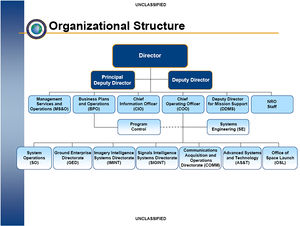National Reconnaissance Office
A member agency of the United States intelligence communiity (IC) and administratively a part of the United States Department of Defense, the National Reconnaissance Office (NRO) is responsible for the design, procurement, launch, and operation of U.S. airborne reconnaissance platforms, including satellites, as well as some unmanned aerial vehicles (UAV) and reconnaissance aircraft. NRO receives the raw output from these platforms, but the output is analyzed by other members of the IC, principally:
- Imagery intelligence: National Geospatial-Intelligence Agency
- Measurement and signature intelligence: Defense Intelligence Agency
- Signals intelligence: National Security Agency
History and Organization
After the May 1960 shootdown of a U-2 reconnaissance aircraft over the Soviet Union, a program which, under the code name AQUATONE, had provided immensely valuable imagery intelligence, the United States was concerned about the vulnerability of even high-altitude reconnaissance aircraft such as the U-2. As early as 946, there had been studies of reconnaissance satellites, and an Air Force requirement was issue in 1955, before the first launch of any type of satellite, the Soviet Sputnik, in 1957.
After delays in an Air Force program, the Central Intelligence Agency was authorized, in 1958, to develop the first photoreconnaissance satellite, the CORONA satellite. Launched in 1960, the first working intelligence satellite was a Navy program, with an overt scientific mission for the GRAB satellite, but that carried, as well, an electronic intelligence payload, Tattletale. Also in 1960, also under an overt scientific mission for the Air Force called the DISCOVERER satellite, the actual payload was CORONA, which took pictures of large areas but without fine detail. President Dwight D. Eisenhower, also in 1960, authorized the Air Force to begin developing the high-resolution GAMBIT satellite. [1] Each of the programs was run by the sponsoring organization, the CIA, Air Force, or Navy, with the only cooperation in use of military space launch facilities.
There were significant technical problems in these CIA and Air Force programs, as well as another Air Force program for the SAMOS satellite. SAMOS had not yet been launched. While an initial White House review assigned the latter project to a subcabinet-level Air Force organization, by 1961, the National Reconnaissance Program (NRP) was being proposed, with the very phrase NRP being classified as TOP SECRET. On 20 July 1961, the NRO was established by a classified directive; the name NRO was classified SECRET. [2] NRO was to be jointly managed by the Air Force and CIA, with Joseph Charyk, with the overt title of Under Secretary of the Air Force, to be its first Director.
The National Photointerpretation Center (NPIC), a separate organization, under the CIA Directorate of Science and Technology but with substantial military staff, analyzed the output of reconnaissance photographs, both from satellites and the U-2. NPIC was headed by Arthur Lundahl, often regarded as the father of U.S. photointerpretation. NPIC was not part of NRO, but of CIA.
Disclosure of the existence of NRO was not seriously discussed until 1992, although the general existence of the programs were not acknowledged, but widely known among defense personnel and contractors, by the late 1960s. Nevertheless, full announcement of the agency took place in 1994, with most details still highly classified. NRO's launch and operations were sensitive compartmented information (SCI, a extra control beyond the regular clasification of intelligence), and in the BYEMAN control system. The images and their interpretation, however, were under a separate SCI codeword, TALENT-KEYHOLE control system.
Original Service-Dependent Structure
For many years, the NRO kept the prior programs in separate organizational units:[2]
- Program A: Air Force imagery intelligence, initially wide coverage
- Program B: CIA imagery intelligence, initially high resolution
- Program C: Navy electronic intelligence, with analysis by the National Security Agency
There were NRO staff for aircraft and space platforms. Eventually, a Program D covered aircraft systems such as the U-2 and SR-71.
Subsequent functional reorganization
Extreme sensitivitity of programs
The "fact of" U.S. reconnaissance satellites was a matter of extreme sensitivity, even after the Soviets were made aware of it as part of arms control negotiations. [The] "Soviet Union could be particularly disturbed by public recognition of this capability [satellite photography]...which it has veiled."[3].
References
- ↑ Richelson, Jeffrey, ed. (13 July 2007), Secrecy and U.S. Satellite Reconnaissance, 1958-1976, vol. National Security Archive Electronic Briefing Book No. 225
- ↑ 2.0 2.1 Charyk, Joseph (20 July 1961), Management of the National Reconnaissance Program (Draft), in Richelson, Jeffrey, The NRO Declassified, vol. National Security Archive Electronic Briefing Book No. 225 Cite error: Invalid
<ref>tag; name "NSAEBB35-02" defined multiple times with different content - ↑ Laird, Melvin R. (June 8, 1972). Memorandum for Assistant to the President for National Security Affairs, Subject: Revelation of the Fact of Satellite Reconnaissance in Connection with the Submission of Arms Limitation Agreements to Congress. Retrieved on 2007-10-02.
- Pages with reference errors
- CZ Live
- Military Workgroup
- Engineering Workgroup
- History Workgroup
- Intelligence Subgroup
- Imagery intelligence Subgroup
- Signals intelligence Subgroup
- Articles written in American English
- All Content
- Military Content
- Engineering Content
- History Content
- Military tag
- History tag
- Intelligence tag
- Imagery intelligence tag
- Signals intelligence tag
